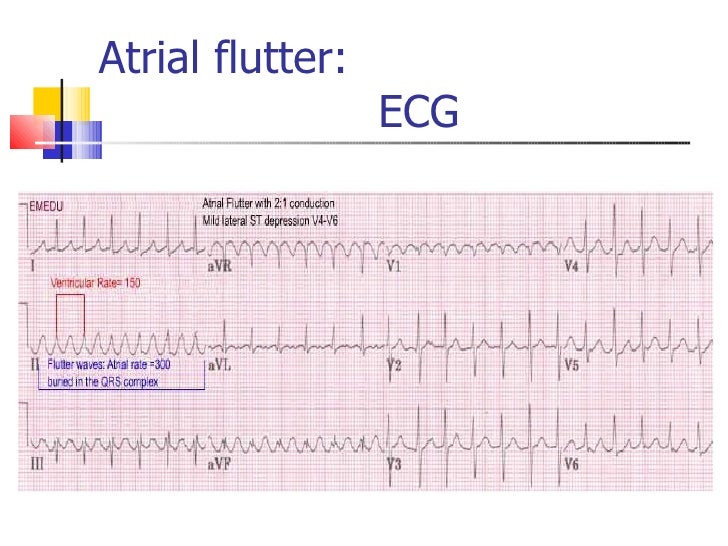

In many individuals, medications are ineffective or cause unwanted side effects which are at times worse than the symptoms of atrial flutter. This prevents the lower chambers from being over stimulated. Rate controlling medications allow atrial flutter to continue, but slow down the heart rate by acting on the AV node. Atrial flutter is sometimes managed with medications. Anti-arrhythmic medications prevent atrial flutter episodes, and these include sotalol, flecainide, and amiodarone. Arrhythmia medications may prevent recurrence, but are not as effective as catheter ablation. DCR does not prevent atrial flutter from returning: there is a 50% chance of developing atrial flutter again in the next 12 months. This “resets” the heart’s electrical system, allowing normal rhythm to resume. Atrial flutter can be terminated with an electrical shock to the chest, delivered under a very brief general anaesthesia. This may be warfarin, or one of the new generation of blood thinners: Pradaxa, Xarelto, or Eliquis. Depending on a number of factors, you may benefit from a blood thinner to prevent blood clot formation and stroke. In some individuals, atrial flutter promotes blood clot formation. Learn more about the different Heart Tests here. Your “ejection fraction” is a key measure of the strength of your heart. Echocardiogram – To evaluate the structure and function of your beating heart. Left atrial size is an important indicator of how established AF has become. Left ventricular size and function provide an idea of whether there is an element of heart failure accompanying your AF.However, if you are in atrial flutter, this assesses whether your heart rate is too rapid, or is well-controlled with medications. Holter monitor – To evaluate your heart rhythm over a 24 h period. If you are in normal rhythm, this may reveal episodes of AF that correspond with your symptoms, or which you may be unaware of.Blood tests – To determine if there is an underlying condition that has provoked your arrhythmia, such as thyroid or electrolyte disturbances and to check the condition of your liver and kidneys.If we aren’t lucky enough to see the beginning or end, then the faster the rate, the more likely it is SVT.You may require the following initial tests: Seeing the beginning or end of the tachycardia is a gift that makes diagnosis easy. If the termination of the tachycardia is also abrupt, we know it is PSVT.

This occurs over and over until something breaks the cycle. That same impulse is able to re-enter the heart and cause another beat. The impulse is delayed in the slow area, then finds when it exits that the heart has recovered from the last beat.

The impulse is caught in a circular pathway that has a slow area within it. A premature beat gets caught in a loop, repeating itself over and over. PSVT is due to a mechanism called re-entry. SVT is often called paroxysmal supraventricular tachycardia (PSVT) because it begins suddenly and ends suddenly. This speeding up and slowing down may take a few seconds or many minutes, but it is not sudden. Then, when the need for the faster rate is past, the heart rate slows gradually. That is, when the body needs a faster rate, chemical signals are sent to the SA node and it speeds up gradually. Sinus tachycardia warms up and cools down. Look for the beginning and/or the end of the tachycardia. This is SVT because there is no obvious reason for sinus tach and the onset was sudden.

ATRIAL FLUTTER VS SVT SKIN
Her skin is warm and dry, and she is not pale or cyanotic. She tells you that she was reading a story to her grandchild when the symptoms started suddenly. In addition, when we sit him down, remove his bunker coat and let him cool off and drink water, the rate gradually returns to normal.Ī woman calls 911 because her heart is racing. This is sinus tach because we can easily explain the reason for the rapid heart rate. He was inside for 30 minutes and is hot and exhausted. For example, a firefighter has just come out of a house fire. This one assessment will usually identify the source of the tachycardia. Look at the patient’s presenting complaint. So, how do we differentiate sinus tachycardia from SVT? Here are four tips that will help. 4 tips to differentiate sinus tach from SVT


 0 kommentar(er)
0 kommentar(er)
